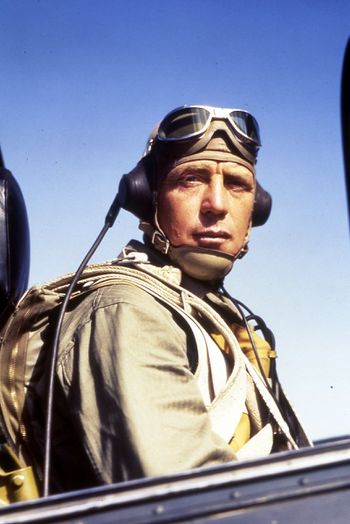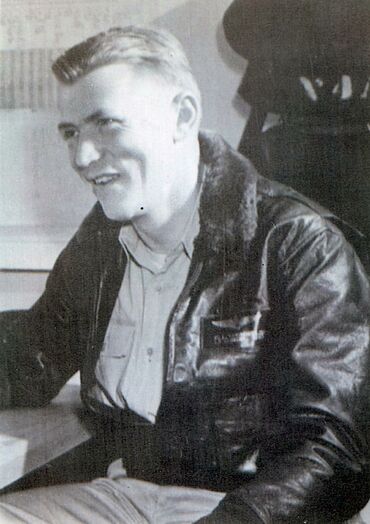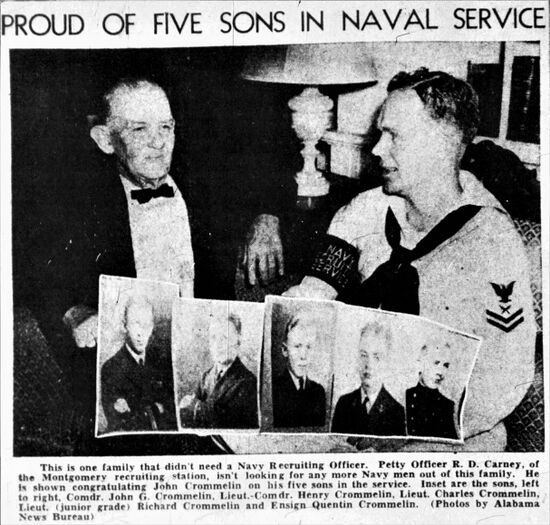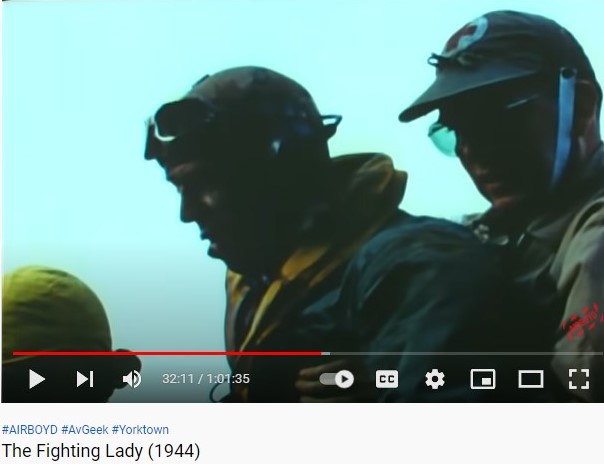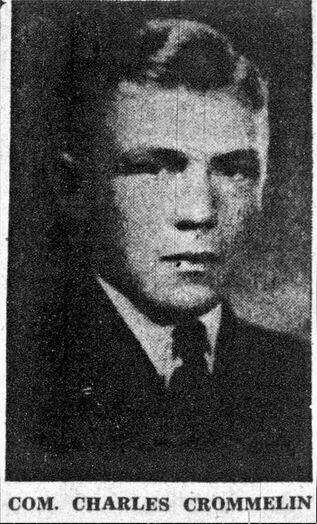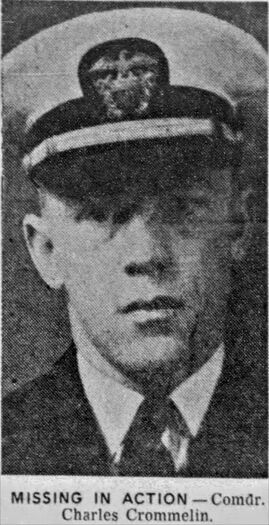CHARLES L. CROMMELIN, CDR, USN
Charles Crommelin '31
Lucky Bag
From the 1931 Lucky Bag:
Charles Laurence Crommelin
Montgomery, Alabama
"Whitey" "Crom"
Charlie is a true son of the South as well as a true Navy man; and he is well up to the standards in both cases. He came to us from Lanier High School and Marion Institute ready to make the best of what was to come, but above all—to graduate.
Whether his task was one of making some training table or attaining a high grade, he tackled one as hard as the other. Although he has been known "to secure," Charlie is generally a hard worker both at studies and athletics. In studies he has always been able to come out with a restful margin on the 2.5. In athletics he has been versatile—sticking to water polo in the winter seasons but declaring himself free during the rest of the year for the sport most suiting his mood—and that seldom meant an afternoon on the radiator.
These traits alone fall far short of giving a description of those qualities for which Charlie is best known. With his good nature, considerateness, and friendliness he will always find a good place in the memory of his classmates.
Swimming 4, 3, s31t; Water Polo 2, 1, s31t; Hop Committee 2, 1; Christmas Card Committee 2, 1
According to the Lucky Bag, Charlie was a member of the Christmas Card Committee responsible for selecting one of the "best ever designs".
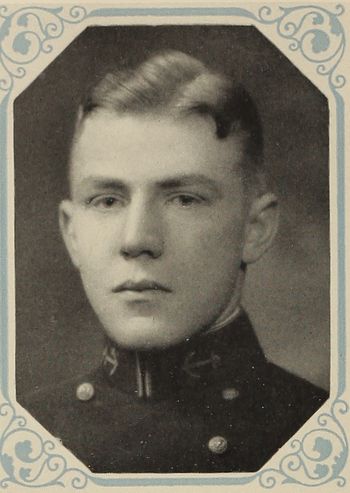
Charles Laurence Crommelin
Montgomery, Alabama
"Whitey" "Crom"
Charlie is a true son of the South as well as a true Navy man; and he is well up to the standards in both cases. He came to us from Lanier High School and Marion Institute ready to make the best of what was to come, but above all—to graduate.
Whether his task was one of making some training table or attaining a high grade, he tackled one as hard as the other. Although he has been known "to secure," Charlie is generally a hard worker both at studies and athletics. In studies he has always been able to come out with a restful margin on the 2.5. In athletics he has been versatile—sticking to water polo in the winter seasons but declaring himself free during the rest of the year for the sport most suiting his mood—and that seldom meant an afternoon on the radiator.
These traits alone fall far short of giving a description of those qualities for which Charlie is best known. With his good nature, considerateness, and friendliness he will always find a good place in the memory of his classmates.
Swimming 4, 3, s31t; Water Polo 2, 1, s31t; Hop Committee 2, 1; Christmas Card Committee 2, 1
According to the Lucky Bag, Charlie was a member of the Christmas Card Committee responsible for selecting one of the "best ever designs".
Loss
From Crommelin.org:
After assuming command of Carrier Air Group 12 he was awarded the Navy Cross for extraordinary heroism during the first carrier force raids on Japan in February 1945. On 28 March 1945 Commander Crommelin volunteered to fly from another aircraft carrier to participate in pre-invasion strikes on Okinawa. He never returned from that mission.
From naval aviation historian Richard Leonard in an email on March 9, 2018:
From USS Hornet (CV 12) War Diary:
CROMMELIN, CHARLES L. 70011 COMDR. USN Temp. Duty CCD5
Missing in action while on active temporary duty with staff, Commander Carrier Division FIVE, as a pilot of an F6F-5 on an authorized photographic mission over enemy territory 28 March 1945. Last seen crashing into water 500 yards off enemy shore after mid-air collision with another F6F-5.CarDiv5 was Hornet, part of TF-58.1 at the time, running missions over Okinawa. If he was flying a photo mission off Hornet, VF-17 would have been the owner of any F6F photo plane. They were always assigned to the VF squadron and not to the VBF squadron. And we know he was flying photo missions not just because of the above, but the TF-58.1 war diary for the period has a photo on the cover specifically credited to the late Commander Charles L. Crommelin.
Other Information
From researcher Kathy Franz:
In 1925, Charles was a member of R. O. T. C. Company A at Lanier High school.
In 1929, his brother John (‘23) was a Navy lieutenant stationed on the Pacific Coast, and brother Henry (‘25) was a lieutenant stationed at a naval post in Rhode Island. Later, the last two brothers also graduated from the Naval Academy: Richard (‘38) who survived the Yorktown and Quentin (‘41.)
Their parents were John and Katherine. Sisters were: Mrs. Raleigh Jenkins of Birmingham, Mrs. W. K. Nierosi and Mrs. T. F. Leak, Jr.
Charles married Annie McCannon on June 11, 1932. Annie was the daughter of Commander George Buckmaster, U. S. N. Charles and Annie’s daughter was named Carol.
While a test pilot in May, 1942, Charles crashed and suffered fractures of both legs and facial abrasions. He was testing the plane for strain under heavy load and had made a successful takeoff. At an altitude of approximately 60 feet, however, his motor stalled and, although he accomplished a safe landing, he hit a shed near the edge of the field in Anacostia, Maryland.
On June 7, 1942, Charles’ father John led the Pearl Harbor Remembrance Day in Montgomery. In January, 1943, Charles’ father John was enroute to Mobile ship yards to inspect a naval ship.
In December, 1943, it was reported that Charles survived 500 wounds in air combat. He made a 100-mile flight back to his ship after an anti-aircraft shell exploded in the cockpit of his plane. Pieces of shell were dug out from his face, chest, stomach, arms and legs. A windshield bolt was imbedded in one leg. His wrist was fractured, and the end of one finger has been snipped off by a bullet.
Within days of each other, his brother John was rescued after floating in the sea on a piece of cork two and a half feet long and four inches thick. He was the senior surviving officer of the carrier Liscome Bay.
On January 22, 1944, a coast-to-coast RCA broadcast “What’s News” included the three Crommelin brothers, Charles, Richard and Quentin. Charles was in a west coast Navy hospital but was able to visit his father in mid-February.
In March, 1945, Charles was in command of Air Groups Five and Twelves and was reported missing following action three days before the Okinawa invasion. He volunteered to fly to another carrier and direct an important pre-invasion strike from that ship. However, he never returned and was reported as killed in action. His brother Richard was reported missing since July 18 and later declared dead.
From Alabama Journal, Montgomery, December 14, 1943 via researcher Kathy Franz:
…On this particular day he was leading a search mission that was to look in on a certain enemy base on its way back to the carrier [USS Yorktown.]
As they approached, Commander Crommelin told his wing man to follow him, and the rest of the planes to stay clear of the island for the time being. The wing man was Ensign M. H. Tyler, of Sulphur Springs, Texas, who dropped into the water near Wake not long ago and was rescued from his liferaft.
Starts First Run
Commander Crommelin said they went over at medium altitude. Then he said he saw a two-engined medium bomber sitting on the ground and thought he also saw a single-engine plane. He instructed Ensign Tyler to watch him and see what happened and then started his first run.
However, there were some overlapping layers of clouds that hid the planes from that direction, so he strafed a group of trucks being used to repair bomb holes in the runways and then pulled up again.
The second run was in the opposite direction, he recounted so that he could see the runway and planes. It was a long strafing run and he could tell he was right on the target.
That run took him down to 350 feet above the runway; then he made a slight left turn. It was at that instant he noticed an A-A battery going full blast and tracers crossing right ahead of him, so he dashed for the clouds, making a slight turn to the right.
Blinded for Seconds
Then it happened. A 20 mm. explosive shell exploded in the cockpit of the plane, about eight inches from his face. He said that for 15 or 20 seconds he was totally blinded and thought he was going down.
Fortunately he remembered he had been in a slight right turn and straightened out the plane automatically. He shook his head and tried to rub his eyes to clear away whatever was blinding him. Then he discovered he could see out of his right eye a little bit and caught a glimpse of the island.
There was blood on him and around the cockpit. He knew he’d been hit in a number of places, he said and could begin to feel pain in his head, leg and right wrist. He was flying then with his left hand and resting his right hand on his leg.
He managed to pass the word to Tyler, that he’d been hit and told him to rendezvous west of the island and lead the way back to the ship.
Cockpit Torn to Pieces
The explosion of the shell had torn the cockpit to pieces. At first all the instruments were out but some of them miraculously came back. Fortunately one was the altimeter so he could know how high he was above the water. The windshield had been shattered. They were flying fast and the rush of wind was so loud he couldn’t hear the radio. His mouth had been torn by shell fragments so that he couldn’t talk plainly, but he did manage to make himself understood.
It was well over 100 miles back to the carrier.
As he flew with one hand, he tried to make a tourniquet to stop the flow of blood from the other. He realized loss of blood might weaken him and that he should be ready to land on the water, so he loosed the straps on his parachute, felt around for and found his one-man liferaft. He released and dropped his belly tank.
His left eye was completely blinded by hemorrhage and blood kept flowing into his right eye and blinding it.
One shell fragment had nipped off the end of a finger. Without knowing this he pulled off his glove to make the tourniquet, and then tried to put it back on. Every time the glove touched the raw flesh it caused intense pain. Finally he simply jammed his hand clear into the glove.
Tyler radioed the ship that the air group commander had been wounded and asked for an emergency landing.
Word spread through the carrier and many who could leave their posts climbed to place of vantage to watch the landing. No one knew how badly the air group commander had been injured, although when he came in close enough the caved-in hood and shattered windshield could be seen.
He might not be able to land; might plunge into the water at the last minute. Or landing in such a condition he might crash. Carrier landings are tricky even when the pilot has complete command of all his faculties. No more dramatic moment could be imagined. Every participant in that landing and every spectator stood tense.
Perfect Landing Made
The damaged plane circled once, came up to the stern of the carrier at exactly the right altitude and then dropped smoothly to the deck in a perfect landing. To make it more astonishing, Commander Crommelin revved his engine and drove the plane forward to the proper spot before he stopped. Medical men carried him to the operating room, where they dug the bolts and debris from his lacerated body.
From Santa Cruz Sentinel, California, August 9, 1945 via researcher Kathy Franz:
Two brothers – navy airmen who fought the Japs in a thousand odd battles from Midway island to the empire itself – were lost in almost identical aerial collisions in recent weeks to break up the fleet’s most famous flying family, it was disclosed today.
Lt. Cmdr. Richard G. Crommelin, 28, holder of two navy crosses, crashed in the sea off Hokkaido during a shipping strike last week. His brother, Cmdr. Charles G. Crommelin, was sent down off Okinawa during that campaign. Both the Crommelins were flying Hellcats and both were caught in bad weather when the collisions occurred at low altitude. Each brother was flying plane No. 13.
The double tragedy followed by about 20 months one of the most notable escapes of the war – Brother John Crommelin’s survival from the torpedoing of the escort carrier Liscome Bay off the Gilbert islands in November, 1943.
The strange pattern of Dick and Charles Crommelin’s death was additionally bizarre in that Charles skippered the fighter squadron on which Dick was serving – in the same capacity – when he went down in the Hokkaido fogs.
Dick Crommelin, with Charles and John, pioneered navy fighter plane tactics in the Battle of Coral Sea and Midway. Dick was shot down after disposing of three enemy planes but was saved by a destroyer.
In the battle of Midway, Dick got another Zero after which he was returned to the states long enough to help produce the famed fighter plane training program film for Walt Disney.
Dick graduated from Annapolis in 1938. He was married and father of two children.
Charles was one of the anonymous stars of the navy’s documentary film, “Fighting Lady.” He was the battered, bleeding pilot who landed a half-wrecked plane on the Lady’s deck and climbed out of the cockpit only to collapse from multiple wounds.
His wife was listed as next of kin.
Photographs
From Hall of Valor:
The President of the United States of America takes pride in presenting the Navy Cross (Posthumously) to Commander Charles Lawrence Crommelin (NSN: 0-70011), United States Navy, for extraordinary heroism in operations against the enemy while serving as Pilot of a carrier-based Fighter Plane and Commander of AIR GROUP TWELVE (AG-12), attached to the U.S.S. RANDOLPH (CV-15), during the first attack on Japan by Naval carrier-based planes on 17 February 1945. Acting as Strike Leader for a coordinated attack on a vital aircraft engine plant in the Tokyo area, Commander Crommelin courageously refused to turn back when he discovered, upon reaching the Japanese coast, that his engine was operating at greatly reduced power and he knew extremely adverse weather conditions made necessary a long trip over the Japanese mainland to the target area. Pressing home the attack in the face of intense and accurate anti-aircraft fire and fighter opposition, he was last to leave the target area, taking damage assessment photographs before delivering his own rocket and strafing attack. Commander Crommelin, by his outstanding professional skill, inspiring leadership and gallant devotion to duty, contributed materially to the serious damage of an important enemy installation, thus upholding the highest traditions of the United States Naval Service.
Service: Navy
General Orders: Commander 1st Carrier Task Force Pacific: Serial 0540 (September 12, 1945)
Distinguished Flying Cross
His two Distinguished Flying Crosses were presented to him by his father-in-law, Rear Admiral Elliott Buckmaster, Commandant of the Naval Air Center, San Diego, California.
From Hall of Valor:
SYNOPSIS: Commander Charles Lawrence Crommelin (NSN: 0-70011), United States Navy, was awarded the Distinguished Flying Cross for extraordinary achievement while participating in aerial flight during World War II. Commander Crommelin lead fighters in support of bombers raiding Marcus Island.
General Orders: Bureau of Naval Personnel Information Bulletin No. 325 (April 1944)
Service: Navy
Rank: Commander
From Crommelin.org:
Commander Charles L. Crommelin, who flew the Hellcat (Grumman F6F), was awarded a Distinguished Flying Cross for action as Commander of a Fighting Squadron in an attack on Marcus Island on 31 August 1943. The following November he was awarded a gold star in lieu of a second Distinguished Flying Cross for action as Commander of Air Group Five during the Gilbert Islands Campaign.
The citation read in part: "While leading an important reconnaissance flight over Mille Atoll on 21 November, in complete disregard for his personal safety and in the presence of determined anti-aircraft fire, he strafed one plane and was maneuvering to attack the other plane when his plane was struck by a shell which exploded within the cockpit, shattering the instruments and severely wounding him. With no vision in his left eye, his right wrist broken, a sever wound in his right chest, as well as many cuts and abrasions on his face, arms and body, and with forward visibility through the cockpit enclosure almost zero, despite loss of blood, he brought his plane back over one hundred miles and made a perfect landing aboard his carrier [the Yorktown]"
Career
He earned his wings as naval aviator #3966 on January 27, 1933.
From Together We Served:
- 1934-1940 VF-2 Bounty Hunters
- 1939-1939 USS Lexington (CV-2)
- 1942-1942 VF-5 Fighting Hell Cats
- 1943-1944 USS Yorktown (CV-10)
- 1943-1944 Carrier Air Group 5 (CAG-5)
- 1944-1945 COMNAVAIRLANT/COMCARGRU 12
- 1945-1945 USS Randolph (CV-15)
From Crommelin.org:
Charles flew Hellcats and was Commander of Carrier Air Group 5 aboard Yorktown. Later he commanded Carrier Air Group 12 aboard the USS Randolph. The book, "Crommelin's Thunderbirds" recounts the action experienced by Air Group 12.
The "Register of Commissioned and Warrant Officers of the United States Navy and Marine Corps" was published annually from 1815 through at least the 1970s; it provided rank, command or station, and occasionally billet until the beginning of World War II when command/station was no longer included. Scanned copies were reviewed and data entered from the mid-1840s through 1922, when more-frequent Navy Directories were available.
The Navy Directory was a publication that provided information on the command, billet, and rank of every active and retired naval officer. Single editions have been found online from January 1915 and March 1918, and then from three to six editions per year from 1923 through 1940; the final edition is from April 1941.
The entries in both series of documents are sometimes cryptic and confusing. They are often inconsistent, even within an edition, with the name of commands; this is especially true for aviation squadrons in the 1920s and early 1930s.
Alumni listed at the same command may or may not have had significant interactions; they could have shared a stateroom or workspace, stood many hours of watch together, or, especially at the larger commands, they might not have known each other at all. The information provides the opportunity to draw connections that are otherwise invisible, though, and gives a fuller view of the professional experiences of these alumni in Memorial Hall.
July 1931
October 1931
January 1932
April 1932
LT Jack Richardson '19
LT Irving Wiltsie '21
LTjg Matthias Marple, Jr. '23
LTjg Robert Larson '24
LTjg James McDonough '24
LTjg Charles McDonald '24
LTjg Arthur Farrell '25
LTjg Carlton Hutchins '26
LTjg Charles Signer '26
October 1932
January 1933
April 1933
July 1933
ENS George Bellinger '32 (USS Nevada)
ENS Dewitt Shumway '32 (USS Nevada)
October 1933
ENS George Bellinger '32 (USS Nevada)
ENS Dewitt Shumway '32 (USS Nevada)
April 1934
July 1934
October 1934
January 1935
April 1935
October 1935
January 1936
April 1936
July 1936
LTjg John Duke '26
CAPT Ernest Pollock '28
LTjg William Pennewill '29
LTjg Gilbert Carpenter '30
LTjg Lance Massey '30
LTjg William Sisko '31
LTjg Albert Major, Jr. '32
January 1937
LT John Duke '26
CAPT Ernest Pollock '28
LTjg William Pennewill '29
LTjg Gilbert Carpenter '30
LTjg Lance Massey '30
LTjg William Sisko '31
1LT Harold Larson '31
ENS Harold Von Weller '33
LTjg Burden Hastings '33
April 1937
CAPT Ernest Pollock '28
LTjg William Pennewill '29
LTjg Gilbert Carpenter '30
LTjg Lance Massey '30
1LT Harold Larson '31
ENS Harold Von Weller '33
LTjg Burden Hastings '33
September 1937
CAPT Paul Moret '30
LTjg Samuel Dealey '30
1LT Harold Larson '31
LTjg Albert Gray '31
LTjg John Spiers '32
LTjg John Phillips, Jr. '33
LTjg Robert Isely '33
CAPT Ernest Pollock '28 (Training Squadron (VN) 2D8)
LT William Pennewill '29 (Training Squadron (VN) 1D8)
January 1938
CAPT Paul Moret '30
LTjg Samuel Dealey '30
1LT Harold Larson '31
LTjg Albert Gray '31
LTjg John Spiers '32
LTjg John Phillips, Jr. '33
LTjg Robert Isely '33
ENS Glenn Dunagan '33
CAPT Ernest Pollock '28 (Training Squadron (VN) 2D8)
LTjg Alden Irons '31 (Training Squadron (VN) 2D8)
July 1938
LTjg John Speer '32 (USS Lexington)
LTjg Robert Goodgame, Jr. '32 (Scouting Squadron (VS) 2)
LTjg Burden Hastings '33 (Torpedo Squadron (VT) 2)
LTjg George Klinsmann '33 (Torpedo Squadron (VT) 2)
ENS Thomas Edwards, Jr. '37 (USS Lexington)
ENS Frank Case, Jr. '38 (USS Lexington)
ENS John Woodruff '38 (USS Lexington)
January 1939
LTjg John Speer '32 (USS Lexington)
LTjg Burden Hastings '33 (Torpedo Squadron (VT) 2)
LTjg George Klinsmann '33 (Torpedo Squadron (VT) 2)
LTjg Thompson Guthrie, Jr. '34 (Scouting Squadron (VS) 2)
ENS Thomas Edwards, Jr. '37 (USS Lexington)
ENS Frank Case, Jr. '38 (USS Lexington)
ENS John Woodruff '38 (USS Lexington)
October 1939
LTjg Burden Hastings '33 (Bombing Squadron (VB) 2)
LTjg Richard McGowan '35 (Torpedo Squadron (VT) 2)
LTjg Clyde McCroskey, Jr. '35 (Scouting Squadron (VS) 2)
ENS Otto Kolb, Jr. '36 (USS Lexington)
ENS Frank Kolb, Jr. '39 (USS Lexington)
ENS Allan Wussow '39 (USS Lexington)
ENS Edward Seiler, Jr. '39 (USS Lexington)
June 1940
LTjg Robert Fair '33 (USS Lexington)
LTjg Clyde McCroskey, Jr. '35 (Scouting Squadron (VS) 2)
LTjg John Hunter '36 (Scouting Squadron (VS) 2)
ENS Allan Wussow '39 (USS Lexington)
ENS Willard Sampson '40 (USS Lexington)
November 1940
LT Clair Miller '29 (Torpedo Squadron (VT) 2)
LT Baylies Clark '30 (Torpedo Squadron (VT) 2)
LTjg Robert Isely '33 (Torpedo Squadron (VT) 2)
LTjg Robert Fair '33 (USS Lexington)
LTjg Joel Davis, Jr. '35 (Bombing Squadron (VB) 2)
LTjg Clyde McCroskey, Jr. '35 (Scouting Squadron (VS) 2)
LTjg Raymond Moore '37 (Torpedo Squadron (VT) 2)
LTjg Thomas Edwards, Jr. '37 (Scouting Squadron (VS) 2)
ENS Edward Price '39 (USS Lexington)
ENS Allan Wussow '39 (USS Lexington)
ENS Edward Seiler, Jr. '39 (USS Lexington)
ENS Willard Sampson '40 (USS Lexington)
April 1941
LT Donald Lovelace '28 (Scouting Squadron (VS) 2)
LT Weldon Hamilton '28 (Bombing Squadron (VB) 2)
LT Clair Miller '29 (Torpedo Squadron (VT) 2)
LTjg Robert Fair '33 (USS Lexington)
LTjg Joel Davis, Jr. '35 (Bombing Squadron (VB) 2)
LTjg John Hunter '36 (Scouting Squadron (VS) 2)
LTjg Raymond Moore '37 (Torpedo Squadron (VT) 2)
ENS Roy Hale, Jr. '38 (Scouting Squadron (VS) 2)
ENS Leonard Thornhill '38 (Torpedo Squadron (VT) 2)
ENS Harry Bass '38 (Bombing Squadron (VB) 2)
ENS Edward Price '39 (USS Lexington)
ENS Allan Wussow '39 (USS Lexington)
ENS Edward Seiler, Jr. '39 (USS Lexington)
ENS Willard Sampson '40 (USS Lexington)
Namesake
USS Crommelin (FFG 37) was named for Charles and his brothers.
Related Articles
Richard Crommelin '38 was one of Charles' younger brothers.
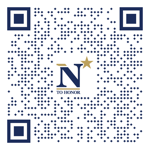
The "category" links below lead to lists of related Honorees; use them to explore further the service and sacrifice of alumni in Memorial Hall.
